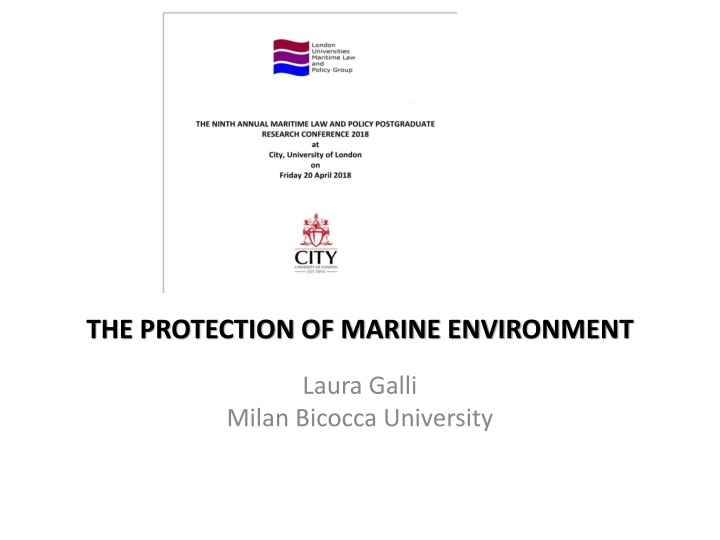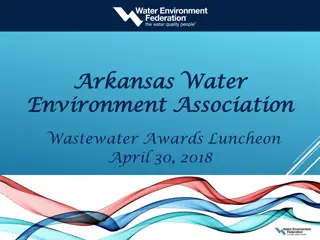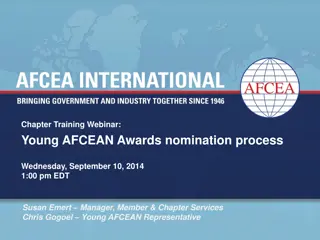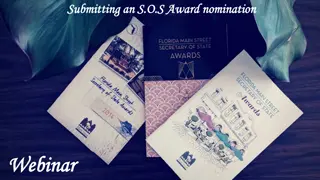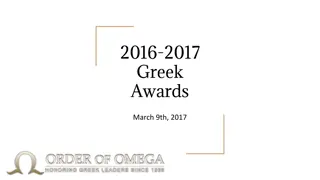UTS Learning & Teaching Awards 2017
Discover the criteria, categories, and eligibility for the 2017 UTS Learning and Teaching Awards and Citations. Explore the changes for this year, such as the new award for Social Impact in Teaching and Learning. Learn about the UTS Model of Learning and the innovative projects within the learning futures framework. Find out how citation winners can progress to national awards and enhance their teaching practices.
Uploaded on Apr 04, 2025 | 0 Views
Download Presentation

Please find below an Image/Link to download the presentation.
The content on the website is provided AS IS for your information and personal use only. It may not be sold, licensed, or shared on other websites without obtaining consent from the author.If you encounter any issues during the download, it is possible that the publisher has removed the file from their server.
You are allowed to download the files provided on this website for personal or commercial use, subject to the condition that they are used lawfully. All files are the property of their respective owners.
The content on the website is provided AS IS for your information and personal use only. It may not be sold, licensed, or shared on other websites without obtaining consent from the author.
E N D
Presentation Transcript
THE PROTECTION OF MARINE ENVIRONMENT Laura Galli Milan Bicocca University
Introduction Marine living resources are of vital importance for mankind because they constitute an important source of protein and so their conservation is to be considered a common interest of the international community. Marine living resources are also important for the international trade and industry of many countries. Hence, conservation is not only a pure scientific or biological concept but involves also economic, political and social elements. Despite its vital importance and the danger that marine pollution represents, the need to regulate it has attracted little attention until recently as the law of the sea focused on the use of the oceans not on the protection of them.
It is only since World War II that international regulation of marine pollution has begun to develop and moved slowly until 1950s. In 1958, Geneva Convention of the High Seas covered a few sources of marine pollution, as discharge of oil from ship and the resulting from exploitation and exploration of seabed and its subsoil. in 1967, the incident of Torrey Canyon raised public and international the attention for vessel source pollution and in 1969 the first international Convention of Civil Liability for Oil Pollution Damage was adopted. in 1970s and 1980s were concluded some treaties about regulation of marine pollution as Marpol 1973, modified by 1978 Protocol, providing the key instruments for regulating pollution from ships till the 1982 s LOSC.
LOSC established a general framework for marine environment protection stating that States have the obligation to protect and preserve the marine environment as in the oceans as in the High Seas. The framework covers all sources of marine pollution and obliges States to take all measures that are necessary to prevent, reduce and control pollution and constitutes a uniformity of rules.
Tipology of marine pollution LOSC defines marine pollution as the introduction by man, directly or indirectly, of substances or energy into the marine environment, including estuaries, which results or is likely to result in such deleterious effects for living resources and marine life, hazards for human health, hindrance to marine activities . This represents an open definition which may include all sources existing and new of marine pollution, identifing six sources of pollution: i) pollution from land- based sources; ii) pollution from seabed activities subject to national jurisdiction; iii) pollution from the activities in the Area; iv) pollution by dumping; v) pollution from vessels and vi) pollution from or through the atmosphere. These sources of marine pollution can be divided into four principal categories: i) land based marine pollution; ii) vessel source marine pollution; iii) dumping; iv) pollution from seabed activities.
Land based marine pollution Land Based marine pollution includes pollution from land based activities and pollution from or through the atmosphere and it is estimated that land based pollution contributes 80 per cent of marine pollution. Pollutans resulting from land based activities include sewage, industrial discharges and agricultural run off and also air pollution that contaminates oceans with dissolved copper, nickel, mercury, lead, zync and synthetic organic compounds. Once emitted, these compounds stay in the air and reach the oceans. So it can be said that land based pollution is a imbalance between human population and industrial activities and the incapacity of the marine environment to contain and absorb the wastes they produce. Considering that 40 per cent of the world s population live within 100 km from the coasts, it is foreseeable that marine pollution from land based activities will increase.
The LOSC is the only treaty that provides general obligation for the States to prevent, control and reduce and not to damage other States in land based activities. Problems: different substances than oil that require different measures to prevent environmental damage; - difficulty to balance the regulation of pollution and economic policies. - ecological and geographical differences in the oceans because they are not homogeneous for currents and winds and, consequently, marine pollution varies in each coastal region.
For this reason, treaties regulating marine pollution were adopted Examples include: the 1980 Protocol for the protection of the Mediterranean Sea Pollution from land based sources (Athens Protocol); the 1983 Protocol for the protection of the South East Pacific (Quito Protocol); the 1992 Convention on the protection of marine environment of the Baltic Sea (Helsinki Convention); the 1992 Convention for the environment of the North East Atlantic (OSPAR Convention); the Syracuse Protocol of 1996 for marine environment protection of Mediterranean Sea. at regional level. protection of marine
Starting point in the regulation of land- based marine pollution is the identification of harmful substances that treaties usually place in a so called black and grey list in which are divided harmful substances. black list substances that States are obliged to eliminate; grey list pollution is merely limited. Problem: regulate the same substances in a uniform way because each treaty divide them differently in the two categories. For example mercury and cadmium were categorised in the grey list by Helsinki Convention and in the black one in Quito Protocol and Athens Protocol. Attempt a replace of the black and grey list upon a uniform approach.
Vessel source marine pollution Vessel source pollution is of two kinds: operational normal operations by ships. It is common practise that oil tankers washed their oil tanks disposing of the oily residue at sea causing oil pollution. Currently, this problem has been almost eliminated by crude oil washing method. accidental accidents involving vessels as Torrey Canyon, Cadiz, Valdez, Erika and Prestige.
Regulation: MARPOL and LOSC. Marpol attempts to completely eliminate international pollution of marine environment through its Protocol and six Annexes (the Annex I and II are mandatory for each Party whilst the remaining Annexes are optional). Each Annex contains provision regulating specific categories of vessel source pollution. Annex I pollution by ships Annex II sea pollution by noxious liquid substances in bulk. Annex III pollution by harmful substances carried by sea in packaged form. Annex IV pollution by sewage from ships. Annex V disposal of garbage from ship, meaning all kinds of domestic and operation waste that can be permitted only for safety of a ship or saving life at sea. Annex VI air pollution by ships.
Under the LOSC, vessel source pollution is regulated by flag States, coastal States and port States. flag State: primarily responsibility to regulate vessel marine pollution. They have to adopt laws to regulate pollution from their vessels that have the same effects of accepted international rules and standards established international organizations, as IMO. For example, board certificates for periodically inspected. required to promptly inform the requesting State of the action taken for any violation and its outcome. by competent which Flag vessels are are also State
Coastal enforcement legislation to regulate vessel source pollution in territorial sea and EEZ (till 200 nm) adding rules and laws to those international rules generally accepted. Measures as inspection and detection against a foreign vessel in the EEZ or territorial sea presuppose clear grounds for believing that the vessel has committed a violation resulting in a significant pollution of marine environment . Measures unlawful reasonably required damage or loss arising from. States exercise legislative and or exceeding responsibility for the those
Port State where a violation is committed in the High Seas or marine spaces under other States Jurisdiction. In the view of the law of dedoublement fonctionnel by George Scelle, the State organ perform a dual role: functions in municipal (national organ); functions in international (international organ). measures against a vessel even legal order legal order
Port State inspection to be limited to documentary examinations except if documentary do not correspond to the real conditions of the vessel or is insufficient or invalid. Port State Control: mechanism to verify whether a foreign vessel has the documentation that complies international rules and standard and aims to the safety of the ship, living and working conditions on board, coordinating the actions between port States, inspections of foreign vessels. physical inspection is avoiding repetitive
Dumping LOSC defines dumping as any deliberate disposal of wastes or other matter from vessels, aircraft, platforms or other man made structures at sea . States have to adopt every measure to reduce, prevent and control pollution of marine environment by dumping, enforcing their laws or rules as those international one within their territorial sea or EEZ or onto their continental shelf. So dumping is not prohibited but restrained.
Regulation: 1972 London Dumping Convention and its 1996 Protocol approaching to the black and grey list. Black list dumping of organic compounds, mercury, cadmium, persistent plastics, crude oil, radioactive wastes and materials . Grey list other waste of materials. 1996 Protocol replaces the black/grey list through a so called reverse listing approach . Here, dumping of wastes is in principle prohibited whilst in the 1972 London Dumping Convention dumped at sea unless it is prohibited. By contrast, nothing may be dumped unless is permitted in the 1996 Protocol. This means a significant reversal of the burden of proof. biological and chemical everything may be
Pollution from seabed activities Drilling operations which produce drilling mud that includes hydrocarbons, heavy metals, zync, nickel. LOSC prescribes States to adopt all measures to prevent, pollution that shall be no less effective than international rules, standards and recommended practises. More details are prescribed from regional conventions, Convention that establishes specific obligation upon Contracting Parties in the exploitation and exploration of Baltic seabed. reduce and control for example Helsinki
Environmental protection of ice covered areas. LOSC doesn t define ice covered areas but it s generally agreed that Arctic is an ice covered area and coastal States have jurisdiction in the limit of EEZ. Arctic Ocean is threatened by multiple sources due to the fragility polar regions ecosystem, including Arctic Ocean and Arctic ice Cap. Impacts of climate change that include sea- level rise, coastal erosion, reduced habitat forming species and ice melting. Ocean acidification. Carbon dioxide emission in the last 200 years has changed the chemistry of the ocean, decreasing its PH and making it more acidic and affect many marine ecosystems.
Differently by Antarctic which is regulated by the 1959 Treaty, there is no framework treaty governing the Arctic Ocean. So, the protection of Arctic Ocean is governed by LOSC and other regional treaties. Particular importance has the international cooperation through the Arctic Council which was established in 1996 by Ottawa Convention and aims to protect Arctic from pollution also through development. Members of the Arctic Council are Canada, Denmark, (including Greenland and Faroe Islands) Finland, Ireland, Norway, The Russian Federation, Sweden and United States. a sustainable
Two important treaties adopted among the Arctic Council activities. The first one about cooperation in aeronautical and maritime Search and Rescue of 2011 and the second one cooperation for protection Pollution in 2013. IMO adopted in 2009 some non binding Guidelines for shipping operation in polar regions which promote safety of navigation through some recommendations equipment, operational protection and in 2014 IMO adopted also the so called Polar Code (Code of safety for shipping operations in Polar Waters). about the marine by Oil about and construction, environmental
Conclusions LOSC represents a general framework to regulate and prevent marine pollution and seeks to limit the discretion of the States to protect marine environment. Land based pollution is the most serious marine pollution source. Weakeness: i) reluctance to reduce economic and industrial activities by the coastal States; ii) the complexity of sources substances and actors involved in land based marine pollution; iii) geographical and ecological divergences in the oceans;
iv) lack of the traditional approach for conservation of marine living resources and biological diversity. Ocean is a natural dynamic system and this is to take into account by rules of international law of sea; v) lack of reciprocity (reciprocal obligations provided by treaties for States) compliance. Reciprocity presupposes a formal equity of States technological, economic differences among States. weak securing and thus and ignores political
A new approach Uniform replacement of the black/grey list and an international control with relevant rules through a reporting system and supervision by a treaty commission. centralized international organization and cooperation among States through international institutions. international Courts and Tribunals in the settlement of international disputes. In this field, ITLOS has made strong commitments in the protection of marine environments and conservation of marine living resources by prescribing provisional measures.
As oceans conditions and marine technology may change over development may consider into account inter - temporal elements so that no rules, customary or conventional, unaffected by time. This interpretation and application of rules of international law of the sea need some efforts if we wish to protect our common interests for the survival and generations. time, a sustainable can remain wellbeing of future
